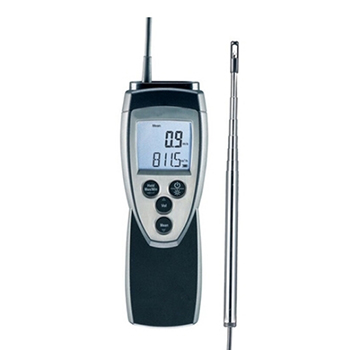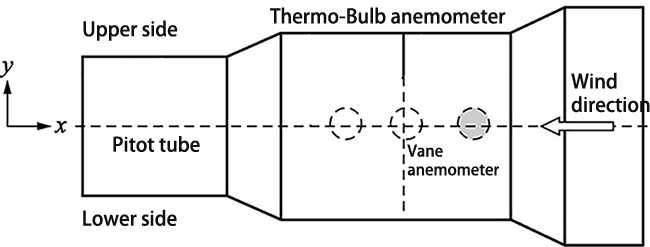An anemometer is an instrument that measures static and dynamic airflow, which can be used to measure wind speed, wind force, and wind direction in the air. It uses a rotating blade and is measured in feet per second or meters per second (m/s). The accuracy of the anemometer is very high, and its readings can have very good accuracy in the range of 0.1 m/s. It can also measure wind speed under low temperatures, low humidity, and other environmental conditions, and can quickly and accurately measure the direction of airflow. So, how much do you know about the working principle of the anemometer? Next, this article will take you to understand the working principle and application knowledge of the anemometer.
Working principle
The basic principle of an anemometer is to place a thin metal wire in a fluid and heat the wire through an electric current to make its temperature higher than that of the fluid, so the wire anemometer is called a "hot wire". When the fluid flows through the wire in the vertical direction, it will take away part of the heat of the wire and reduce the temperature of the wire.
According to the theory of forced convection heat exchange, there is a relationship between the heat Q lost by the hotline and the velocity v of the fluid. A standard hot wire probe consists of a short, thin wire stretched between two brackets. Metal wire is usually made of platinum, tungsten, and other metals with high melting points and good ductility. The commonly used wire has a diameter of 5μm and a length of 2 mm; the smallest probe has a diameter of only 1μm and a length of 0.2 mm.
The commonly used wire diameter is 5μm and the length is 2mm. The small probe diameter is only 1μm and the length is 0.2mm. According to different purposes, hot wire probes can also be made into double-wire, triple-wire, diagonal, V-shaped, X-shaped, etc. In order to improve the strength, sometimes a metal film is used instead of a metal wire, and a layer of metal film is usually sprayed on the heat-insulating substrate, which is called a hot film probe.
The hot wire probe must be calibrated before use, and the static calibration is carried out in a special standard wind tunnel. Measure the relationship between flow rate and output voltage and plot it as a standard curve. Dynamic calibration is performed in a known pulsating flow field, or a pulsating electrical signal added to the anemometer heating loop is used to verify the frequency response of the hot wire anemometer. If the frequency response is not good, it can be improved by using the corresponding compensation circuit.
Application
- Measure the velocity and direction of the average flow.
- Measure the pulsating velocity of the incoming flow and its frequency spectrum.
- Measure the Reynolds stress in turbulent flow and the velocity dependence and time dependence of two points.
- Measure wall shear stress (usually by using a hot film probe placed flush with the wall, the principle is similar to hot wire velocity measurement).
- Measuring the fluid temperature (first measure the change curve of the probe resistance with the fluid temperature, and then determine the temperature according to the measured probe resistance. In addition, many professional uses have been developed.
- Applied to electric power, iron and steel, petrochemical, energy saving, and other industries.
Anemometer measuring range
The flow velocity measurement range from 0 to 100m/s can be divided into three sections.
Low speed: 0 to 5m/s
Medium speed: 5 to 40m/s
High speed: 40 to 100m/s.
The thermal probe of the anemometer is used for accurate measurement of 0 to 5m/s; the rotary probe of the anemometer is ideal for measuring the flow velocity of 5 to 40m/s. An additional criterion for the correct selection of the flow rate probe of the anemometer is the temperature. Usually, the temperature of the thermal sensor of the anemometer is about ±70°C. The rotor probe of the special anemometer can reach 350°C, and the tube is used above 350°C.
Anemometer measurement
- Measure the velocity of the gas flow in the duct. The practice has proved that the 16mm probe of the anemometer is the most versatile. Its size not only ensures good permeability but also can withstand a flow velocity of up to 60m/s.
- The measuring vents in the air extraction and exhaust have a relatively balanced distribution of airflow in the pipeline: a high-speed area is generated on the surface of the free vent, the rest of the parts are low-speed areas, and vortices are generated on the grid. According to the different design methods of the grid, the airflow section at a certain distance (about 20cm) in front of the grid is relatively stable. In this case, a large-bore anemometer is usually used for measurements. This is because the larger bore is able to average the unbalanced flow rate and calculate its average value over a larger range.
- In the measurement of the air extraction hole, even if there is no grid interference at the air extraction point, the airflow route will have no direction, and its airflow section will be extremely uneven. The reason is that the partial vacuum in the pipeline draws the air out of the air chamber in a funnel shape, and even in the area very close to the pumping, there is no position that meets the measurement conditions for measurement operations.
For measuring with grid measurement with averaging function to determine volumetric flow measurement and volumetric flow, only pipe or funnel measurement provides reproducible measurement results. In this case, measuring funnels of different sizes can meet the requirements of use. Using the measuring funnel, a fixed cross-section that meets the flow velocity measurement conditions can be generated at a certain distance in front of the sheet valve, and the center of the cross-section can be measured and fixed to fix the cross-section. The measured value obtained is multiplied by the funnel factor to calculate the volume flow drawn.

